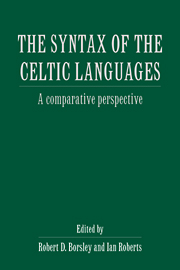Book contents
- Frontmatter
- Contents
- List of contributors
- Introduction
- 1 Long head movement in Breton
- 2 Some syntactic effects of suppletion in the Celtic copulas
- 3 Fronting constructions in Welsh
- 4 Bod in the present tense and in other tenses
- 5 Pronominal enclisis in VSO languages
- 6 Aspect, agreement and measure phrases in Scottish Gaelic
- 7 A minimalist approach to some problems of Irish word order
- 8 Subjects and subject positions in Irish
- 9 Negation in Irish and the representation of monotone decreasing quantifiers
- 10 On structural invariance and lexical diversity in VSO languages: arguments from Irish noun phrases
- References
- Index
6 - Aspect, agreement and measure phrases in Scottish Gaelic
Published online by Cambridge University Press: 18 December 2009
- Frontmatter
- Contents
- List of contributors
- Introduction
- 1 Long head movement in Breton
- 2 Some syntactic effects of suppletion in the Celtic copulas
- 3 Fronting constructions in Welsh
- 4 Bod in the present tense and in other tenses
- 5 Pronominal enclisis in VSO languages
- 6 Aspect, agreement and measure phrases in Scottish Gaelic
- 7 A minimalist approach to some problems of Irish word order
- 8 Subjects and subject positions in Irish
- 9 Negation in Irish and the representation of monotone decreasing quantifiers
- 10 On structural invariance and lexical diversity in VSO languages: arguments from Irish noun phrases
- References
- Index
Summary
Introduction
The goal of this chapter is to defend an extended version of the Visibility Criterion (Chomsky 1986a) whereby the link between Theta Theory and Case Theory is generalized. We will argue that the Case-theoretic requirement in the formulation of Visibility should be replaced with a requirement of co-indexation with a functional head; the relevant functional heads being Agreement (Agr) and Tense (T). We will argue that Tense involves two functional heads which are composed into a single chain via the mechanism of selection. This allows the incorporation of aspectual information into the licensing condition. By aspectual we mean the indirect relationship between the utterance time and the time of the event denoted by the verb.
Scottish Gaelic (SG) is particularly relevant to both the extended version of Visibility and to the composition of tense information into a single chain because of two factors: firstly, co-indexation with Agr in SG correlates with word order; and secondly, composition of tense information is transparently reflected in the morphological form of tense and aspect particles. Given these two factors, the extended version of Visibility predicts that certain word orders in SG will be forced or ruled out. This phenomenon is particularly clear with respect to the syntax of measure phrases in the language, which we show to be sensitive to aspectual information.
Generalized Visibility
Typically, argument NPs have to be licensed in two ways: they must be licensed by Theta Theory and they must be licensed by Case.
- Type
- Chapter
- Information
- The Syntax of the Celtic LanguagesA Comparative Perspective, pp. 200 - 222Publisher: Cambridge University PressPrint publication year: 1996
- 7
- Cited by



